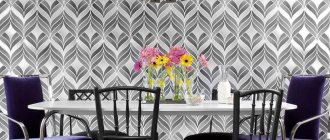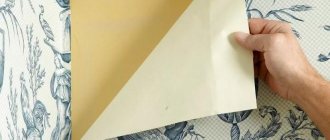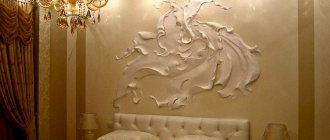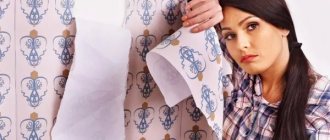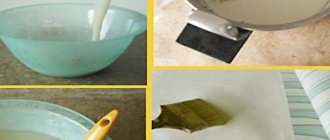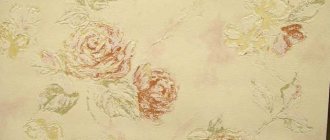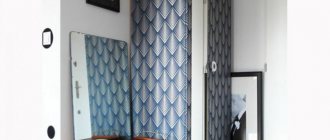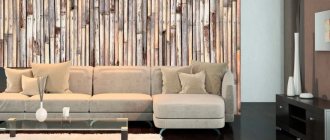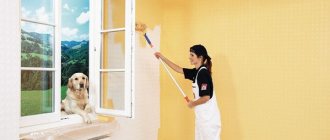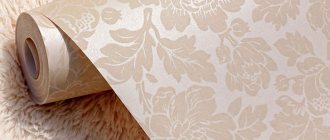A short explanation of all the symbols on the wallpaper
If you don’t have time to read the entire article, then we present the meaning of the most common icons on wallpaper.
Decoding the markings on the wallpaper
Wallpaper from any manufacturer is marked with symbols in the form of drawings. The pictograms on the label provide information directly about the characteristics of the wall covering.
If you plan to wash the wallpaper in the future, or the coating will be applied in a room with high humidity, you need to look for rolls with a wave icon. This designation will tell you about the wallpaper care options.
| Water resistant . The wallpaper is suitable for rooms with high humidity and is not afraid of water ingress. Fresh stains can be cleaned with a damp sponge or cloth. The use of detergents is prohibited. |
| Washable . It is allowed to clean the canvas with a wet sponge or rag with the addition of gentle detergents (liquid soap, gel). |
| Super washable . Designation of wet cleaning using any cleaning agents other than abrasive ones (some powders, pastes, suspensions). |
| Dry cleaning . Dry brushing |
| Wear-resistant . The designation of a brush with a wave indicates that the canvas is cleaned with a damp sponge or brush. |
| Friction resistance . Cleaning with a brush or sponge with the addition of detergents is allowed |
Designations on wallpaper - light fastness
The sun symbol indicates the lightfastness of the wallpaper. Each icon corresponds to the degree of fading of the coating due to regular exposure to sunlight.
| Moderate light fastness . Wallpaper quickly loses color. Suitable for shaded areas. |
| Relative light fastness . Partially resistant to sunlight. Not recommended for rooms with windows facing the sunny side. |
| Light-resistant wallpaper . Designation of wall coverings for rooms on the sunny side. |
| Very light fast . The coating tends to retain color for a long time |
| Maximum light resistance . The coating lasts without fading. |
Designations on the wallpaper - joining the pattern
Markings with arrows indicate the method of combining the canvases. The designations indicate both an arbitrary sticker and precise joining of the elements of the design.
| No docking. The canvases are glued randomly; pattern matching is not required. |
| Docking on the same level . The pattern is adjusted to the same level as the adjacent piece (on the packaging the designation may be repeat 64/0, for example). |
| Step combination. On the new roll the design should be half higher than on the glued one. |
| Counter sticker . Two arrows in the opposite direction mean that each new piece is glued with a 180° turn. |
| Direct gluing . Sometimes there is a designation in the form of a straight arrow. It says that the canvas is glued strictly in a given direction. |
| Exact offset . The numerator is the height (step) of the pattern, the denominator is the amount of displacement of the canvases. |
Marking on wallpaper - applying glue
The brush icons will tell you how to glue wallpaper. By the designation you can understand where to apply the adhesive (on the canvas or the surface to be pasted).
| Applying glue to the wall . The adhesive composition is applied only to the surface to be glued. |
| Applying glue to wallpaper . Only canvases can be applied with glue. |
| Wallpaper is self-adhesive after wetting . The canvases are by default, before pasting it is enough to moisten them with a damp cloth or sponge. |
| Special glue . For pasting, a special adhesive is required. |
Let's start the calculation
We found out all the sizes - it's time to start doing math.
Let's say buyers are going to wallpaper a bedroom. Room parameters: ceilings 2.6 m high, wall lengths 5 m and 3 m.
They choose between two articles: 1.06x10 m with a 32 cm report (view A) and 1.06x10 m with a 64/32 cm report (view B). Let's calculate the number of rolls of both types.
1. Let's calculate the total perimeter of the room:
(5 m + 3 m) * 2 = 16 m
2. Calculate how many wallpaper strips we need
— the perimeter is divided by the width of the roll. It is the same for both types of articles:
16 m / 1.06 m = 15.09
Round up to get a whole strip.
3. Find out the length of the wallpaper strip.
To do this, we will clarify the height of the ceiling, adding 5 cm for trimming the wallpaper and the amount of repeat. For article B, let’s also add the offset value:
view A: 2.6 m + 0.05 m + 0.32 m = 2.97 m
view B: 2.6 m + 0.05 m + 0.64 m + 0.32 m = 3.61 m
4. Let's calculate how many strips can be cut from one roll.
To do this, divide the length of the roll by the length of the strip:
view A: 10 m / 2.97 m = 3.37
view B: 10 m / 3.61 m = 2.77
Round down to the nearest whole number to get only whole canvases.
5. Let's calculate how many rolls we need
— divide the required number of wallpaper strips by their number in 1 roll:
type A: 16 pcs. / 3 pcs. = 5.33 -> 6 pcs.
type B: 16 pcs. / 2 pcs. = 8 pcs.
Uneven numbers are rounded up because wallpaper is only sold in whole rolls.
Now you know how to calculate the required amount of wallpaper. Don't forget to tell the buyer to take enough wallpaper in case of damage or mistakes during gluing.
Wallpapering (installation)
Methods of applying glue and joining the pattern have their own symbols. But there is a sign indicating a special gluing technology.
Invisible docking. The sheets are glued with an overlap of 4-6 cm; after pasting is completed, it is carefully cut off.
Removing wallpaper (dismantling)
The markings will show how easily the wallpaper can be removed from the walls. Understanding icons will come in handy when it comes time to update your interior.
| Completely removable. The coating is easily removed without the use of equipment. |
| Partially removed. They are removed in layers using a scraper and sometimes water. New material can be glued to the very bottom layer. |
| Removed after wetting. They are removed after preliminary application of liquid to the canvas. |
Other designations on wallpaper
Manufacturers have provided the market with anti-vandal, fire-resistant and other wall coverings. Special icons will help you decipher unfamiliar symbols.
| Wallpaper with top embossing . The canvas has several layers. |
| Fire resistant. Treated with a special compound that is difficult to ignite. |
| Shock resistant. Anti-vandal wallpaper made of very durable material that is resistant to external mechanical influences. |
| For painting. The roller designation indicates that the material can be repeatedly painted with any dispersion paint. |
In addition, wallpaper produced in EU countries may have special markings, for example, Gütegemeinschaft Tapete eV. This organization has developed special regulations for the quality and testing of wallpaper, which indicate technical requirements, as well as standards regarding harmlessness to health and the environment . The European Union has a special, independent supervisory body that monitors compliance with such regulations.
Wallpaper quality mark
Another marking that meets the requirements of EU directives is the CE mark, which is used for the entire range of construction and finishing products. The CE mark placed on the wallpaper label means that the manufacturer guarantees that the quality of this product complies with the currently valid EU directives regarding the quality of construction products.
EU legislation is very strict in matters of this kind, so the presence of such designations on the label is an additional plus in favor of a particular product.
CE mark for construction products
Letter designation on wallpaper
Not all manufacturers write what is included in the composition and what the properties of the coating are. But the presence of letter designations is always present. The abbreviations are explained below:
| A | Acrylic. Breathable material, suitable for residential areas. |
| B | Paper. Paper-based covering mainly for living rooms. |
| BB | Foamed vinyl. A coating with a pronounced relief masks defects and visually enlarges the room. |
| PV | Flat vinyl. Vinyl wallpaper with flat pattern. |
| RV | Embossed vinyl. Non-woven base with embossed design. |
| TKS | Textile wallpaper. Non-woven or paper wallpaper with textile overlay. |
| STL | Glass wallpaper. Durable fireproof material, resistant to mechanical stress. |
| STR | Structural for painting. Dense material, usually white. Subject to repeated painting. |
| A+ | Ceiling covering. Special material for gluing ceilings, not for walls |
Letter designations
Let's take a closer look at what the symbols on the roll wrapper say. They will tell you what the wallpaper is made of.
- A – acrylic
- B – paper
- BB – foamed vinyl
- PV - flat vinyl
- RV – embossed vinyl
- TKS – textile
- STR – structural (for painting)
- STL – glass wallpaper.
What do the patterns on the wallpaper mean
? So, acrylic is a special polymer that is now very often used for the manufacture of various finishing materials. Such wallpaper will be quite affordable for any buyer. They have such a positive property as good breathability. This allows you to use them for walls, both children's and any other room in your apartment.
Paper wallpapers come in single-layer and multi-layer types, which have good resistance to moisture and light. They have always been very popular. And modern technologies have made it possible to improve and expand their properties and characteristics. There are a huge number of types of vinyl wallpaper: structural, hot stamping, based on foamed vinyl, photo wallpaper. The base can be either non-woven fabric or paper. They were first released in the 40s of the 20th century after the American chemist Waldo Simon received a patent for the manufacture of various products from polyvinyl chloride.
Textile wallpaper is distinguished by its high cost and the need for delicate care. After all, their top layer consists of natural materials (linen, cotton, jute), therefore, they are very sensitive to moisture and light. Glass wallpaper is made from fiberglass. Experts recommend using them for finishing walls of non-residential premises. After all, they are very wear-resistant, withstand strong friction and are fireproof.
Decoding the symbols on the wallpaper (video)
The meaning of the numbers on the roll
Symbols on the label in the form of numbers also provide useful information.
| vendor code | Wallpaper design code number. |
| Batch number | Contains information about the number of the production line and shift, and color features. When purchasing, it is recommended to choose rolls with the same batch number, otherwise you can purchase canvases with a slight difference in tone. |
| Size | The width of the web and the length of the roll are indicated. |
Important! On each roll of wallpaper, on the packaging label there is a release date and a batch number, sometimes also called a batch number. The batch number is important for the buyer, since wallpaper from different batches may have significant color differences. Therefore, we must strive to buy rolls from the same batch. If this is not possible, rolls from different batches should be distributed on opposite walls, in which case the difference in color will be least noticeable.
Other meanings of this word:
Random riddle:
There's a freak standing in the middle of the garden, He's angry at everyone, But he's nice to everyone.
Random joke:
Evening, the Rostovs’ salon is crowded. They tell different stories. Lieutenant Rzhevsky's turn. - Well, gentlemen, it happened during the Battle of Borodino. This means that our squadron is going on the attack, then suddenly there is an explosion next to me, I am knocked out of the saddle, I jump up - my comrades are killed, my saber is broken, and three hefty French cavalrymen are rushing towards me at full speed with their sabers drawn. Gentlemen, I'm ashamed, but I crap myself. There is silence in the cabin, finally someone says: “Lieutenant, you are, of course, too frank, but given the circumstances - shell shock from the explosion, three against one, a feeling of imminent death.” There is nothing shameful in this, I think it can happen to anyone. - No, gentlemen, you don’t understand - I’m shitting myself NOW.
Did you know?
From natural gas (from 1 well in a year) you can get as much artificial wool as wool from 62 thousand sheep in a year.
